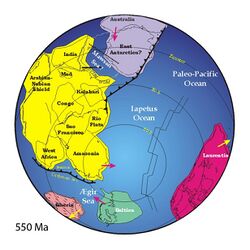Wilson cycle

The Wilson cycle is a model where a continent rifts, forms an ocean basin in-between, and then begins a process of convergence that leads to the collision of the two plates and closure of the ocean. The model is named after its originator John Tuzo Wilson. It has been suggested that Wilson cycles on Earth started about 3 Ga (3 billion years) ago in the Archean Eon of Earth's history.[1]
A Wilson cycle is not the same as a supercontinent cycle, which is the break-up of one supercontinent and the development of another and takes place on a global scale. The Wilson cycle rarely synchronizes with the timing of a supercontinent cycle.[2] However, supercontinent cycles and Wilson cycles were both involved in the creation of Pangaea and Rodinia.[3]
References
- ↑ Shirey, Steven B.; Richardson, Stephen H. (2011). "Start of the Wilson Cycle at 3 Ga Shown by Diamonds from Subcontinental Mantle". Science 333 (6041): 434-436. doi:10.1126/science.1206275. http://science.sciencemag.org/content/333/6041/434.
- ↑ Rogers, John J.W., and M. Santosh. Continents and Supercontinents. Oxford: Oxford UP, 2004. Print.
- ↑ Fluteau, Frédéric. (2003). "Earth dynamics and climate changes". C. R. Geoscience 335 (1): 157–174. doi:10.1016/S1631-0713(03)00004-X

